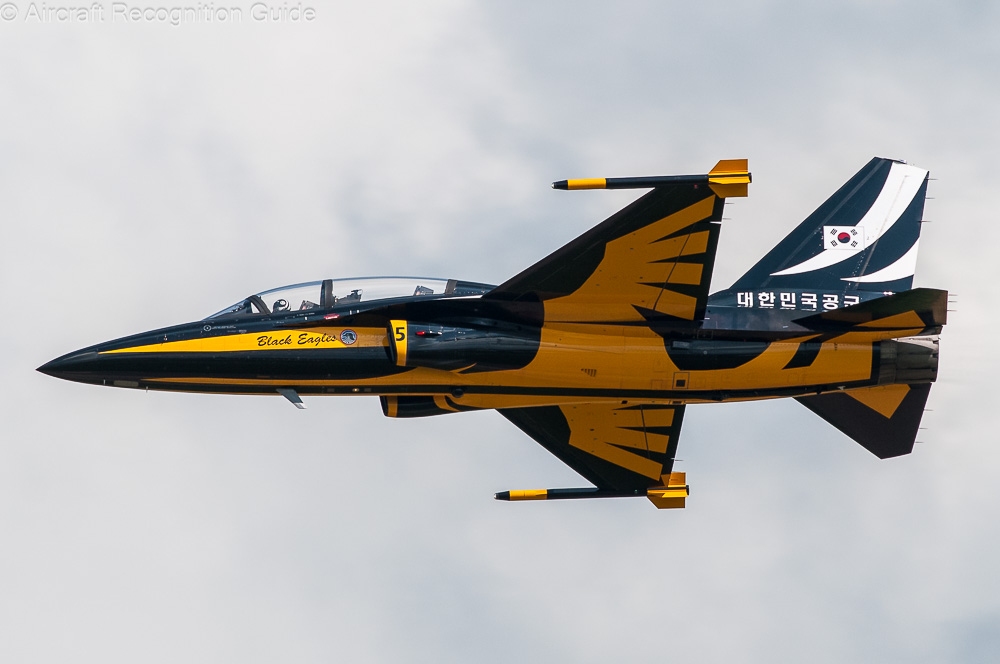
KAI T-50 Golden Eagle
South Korea's 21st century advanced trainer is a product of Korea Aerospace Industries (KAI) with the help of Lockheed-Martin. Hence it is no surprise that the T-50 contains some elements that seem 'borrowed' from the F-16. Look for example at the cropped delta wings with leading edge root extensions, tail, rear fuselage and main landing gear. Other characteristics are different though, such as the standard tandem canopy, that curves nicely into the dorsal fin. Also, the nose gear retracts forward and hides behind a long, single door. Finally the KAI aircraft has an air intake under each leading edge extension, with a rounded rectangular shape.
T-50 & T-50B
T-50 is the basic training version. When adapted to the specific needs of a user, a suffix may be added like T-50i for Indonesia and T-50TH for Thailand. There is also a dedicated aerobatic version, called T-50B in Korean military service. All photos above are of the T-50B, in the colours of the Black Eagles, the demo team of the Republic of Korea Air Force (RoKAF). Both versions have in common a pointed top of the vertical stabiliser; the front is higher than the end. Additionally, both have no cannon.
FA-50
The dedicated fighter variant is designated FA-50, of "Fighter Attack". Logically the FA-50 is an armed version of the T-50. It has pylons for the storage of weapons under the wings and at each wing tip. Furthermore, the FA-50 has a cannon in the top of the left wing-fuselage fairing, just above the air intake. Finally, the top of the vertical stabiliser is flat, so not pointed like on the similar TA-50 described below. Here you have the way to keep them apart!
This FA-50 has no pylons under the wings, but the mouth of the cannon between the canopy and air intake is clearly visible, as is the non-pointed top of the vertical fin. (photo: KAI/WikiMedia)
TA-50
Being a mix of the T-50 and FA-50, the TA-50 can be seen as a less expensive, less capable light fighter, that can be used as a lead-in trainer for more advanced fighters. Like the FA-50 it has pylons under the wings and at each wing tip, and a cannon. However, the TA-50 retains the pointed top of the vertical stabiliser, avoiding a mix-up with the FA-50.
Here is an armed TA-50, showing as well the cannon. Note the pointed top of the vertical stabiliser! (photo: KAI/WikiMedia)
Confusion possible with
AIDC F-CK-1B/D & T-5

In a way the Taiwanese F-CK-1B and -D two seat fighter and T-5 advanced trainer derived from it have similar characteristics as the F-16 as well. In particular the blended wing-fuselage transition and main landing gear are an example. The T-5 and T-50 share these features, and the pointed top of vertical stabiliser. Compared to the T-50 the F-CK-1 and T-5 have two engines though, the nose gear door on the right side, a lower nose (resulting in a flat underside) and oval air intakes tilted 45 degrees. (photo: Makoto Lin/WikiMedia)
Hongdu L-15

This Chinese derivative of the Yakovlev Yak-130 has two engines exhausts that extend beyond the tail, fed by forward tilted air intakes below the leading edge extensions of the wings. The gear is shorter though, the nose gear has a trailing link and two small doors. (photo: Xu Zheng/WikiMedia)
Aermacchi M346
While this Italian jet has two engines, which should already be enough to avoid confusion, the large tail, lead edge root extensions and location of air intakes could make you doubt. But then a look at the gear and location of exhausts should take these doubts away.





